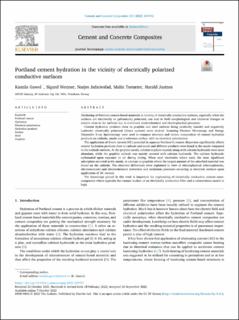| dc.contributor.author | Gawel, Kamila | |
| dc.contributor.author | Wenner, Sigurd | |
| dc.contributor.author | Jafariesfad, Narjes | |
| dc.contributor.author | Torsæter, Malin | |
| dc.contributor.author | Justnes, Harald | |
| dc.date.accessioned | 2022-10-18T09:03:33Z | |
| dc.date.available | 2022-10-18T09:03:33Z | |
| dc.date.created | 2022-10-13T08:17:01Z | |
| dc.date.issued | 2022 | |
| dc.identifier.citation | Cement and Concrete Composites, 2022, 134, 1-9 | en_US |
| dc.identifier.issn | 0958-9465 | |
| dc.identifier.uri | https://hdl.handle.net/11250/3026573 | |
| dc.description.abstract | Hardening of Portland cement-based materials in vicinity of electrically conductive surfaces, especially when the surfaces are electrically or galvanically polarized, can lead to both morphological and chemical changes in cement close to the surfaces due to combined electrochemical and electrophysical processes.
Cement hydration products close to graphite and steel surfaces being positively (anode) and negatively (cathode) electrically polarized (direct current) were studied. Scanning Electron Microscopy and Energy Dispersive X-ray Spectroscopy were used to compare structure and atomic composition of cement hydration products on cathode, anode and a reference surface with no electrical polarization.
The application of direct current (DC) potential in aqueous Portland G cement dispersion significantly affects cement hydration products close to cathode and anode and different products were found at the anode compared to the cathode surfaces. At the graphite anode, calcium sulphate crystals along with calcium hydroxide were most abundant, while the graphite cathode was mainly covered with calcium hydroxide. The calcium hydroxide carbonated upon exposure to air during drying. When steel electrodes where used, the most significant adsorption occurred at the anode, in contrast to graphite where the largest amount of the adsorbed material was found on the cathode. The observed differences were explained in view of electrophysical (electrophoresis, electroosmosis) and electrochemical (reduction and oxidation) processes occurring at electrode surfaces upon application of DC current.
The knowledge gained in this work is important for engineering of electrically conductive cement nano-composites where typically the contact surface of an electrically conductive filler and a cementitious matrix is high. | en_US |
| dc.language.iso | eng | en_US |
| dc.publisher | Elsevier | en_US |
| dc.rights | Navngivelse 4.0 Internasjonal | * |
| dc.rights.uri | http://creativecommons.org/licenses/by/4.0/deed.no | * |
| dc.subject | Graphite | en_US |
| dc.subject | Steel | en_US |
| dc.subject | Surface | en_US |
| dc.subject | Hydration products | en_US |
| dc.subject | Electrical polarization | en_US |
| dc.subject | Hydration | en_US |
| dc.subject | Portland cement | en_US |
| dc.title | Portland cement hydration in the vicinity of electrically polarized conductive surfaces | en_US |
| dc.title.alternative | Portland cement hydration in the vicinity of electrically polarized conductive surfaces | en_US |
| dc.type | Peer reviewed | en_US |
| dc.type | Journal article | en_US |
| dc.description.version | publishedVersion | en_US |
| dc.rights.holder | © 2022 The Authors. Published by Elsevier Ltd. | en_US |
| dc.source.pagenumber | 9 | en_US |
| dc.source.volume | 134 | en_US |
| dc.source.journal | Cement & Concrete Composites | en_US |
| dc.identifier.doi | 10.1016/j.cemconcomp.2022.104792 | |
| dc.identifier.cristin | 2060991 | |
| dc.relation.project | Norges forskningsråd: 285568 | en_US |
| dc.source.articlenumber | 104792 | en_US |
| cristin.ispublished | true | |
| cristin.fulltext | original | |
| cristin.qualitycode | 1 | |

